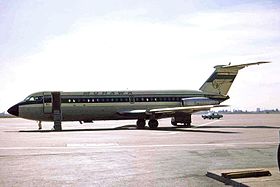Mohawk Airlines Flight 40
| Mohawk Airlines Flight 40 | |
|---|---|
|
Identical BAC 1-11 -200 of Mohawk Airlines |
|
| Accident summary | |
| Accident type | Loss of control after fire |
| place | 1 mile east of Blossburg , Pennsylvania , USA |
| date | June 23, 1967 |
| Fatalities | 34 |
| Survivors | 0 |
| Aircraft | |
| Aircraft type | BAC 1-11-204AF |
| operator | Mohawk Airlines |
| Mark | N1116J |
| Departure airport | Elmira Regional Airport |
| Destination airport | Washington National Airport |
| Passengers | 30th |
| crew | 4th |
| Lists of aviation accidents | |
On June 23, 1967, a BAC 1-11 crashed on Mohawk Airlines Flight 40 from Elmira Regional Airport to Washington National Airport as a result of a fire that caused the elevator control to fail. The crash every 34 occupants were killed.
plane
The accident BAC 1-11-204AF ( license plate : N1116J, s / n : 098) was equipped with two engines of the type Rolls-Royce Spey 506-14 equipped and completed on August 1, 1966 its first flight. The machine was delivered to Mohawk Airlines on August 5, 1966 and had completed 2246 flight hours by the time of the accident.
the accident
The machine was to make a scheduled flight from Syracuse ( New York ) to Washington, DC with a scheduled stop in Elmira . The aircraft landed in Elmira at 2:07 p.m. local time and took off there at 2:39 p.m. for the onward flight to Washington. Five minutes after taking off from Elmira Regional Airport received the pilot release, the climb up to 4,875 meters (16,000 feet continue) and headed straight for Harrisburg ( Pennsylvania ) to take.
Over the next three minutes, unnoticed by the pilots, a fire spread in the stern section behind the cabin, causing both hydraulic systems to fail and they lost control of the elevator . The aircraft went into an uncontrollable dive and disappeared from the air traffic control radar at 2:47 p.m. without receiving an emergency call beforehand. The BAC-1-11 hit one statute mile east of Blossburg in Tioga County, Pennsylvania.
Cause of accident
The cause of the fire was a faulty check valve in the engine, through which hot bleed air from the compressor got into the auxiliary engine (APU). The hot air flowed through a second valve in the APU into the rearmost fuselage section below the tail unit and ignited the sound-absorbing inner lining in this area. The fire damaged the hydraulic lines running there. The flammable hydraulic fluid fed the fire, causing it to spread quickly inside the vertical stabilizer. The hydraulic loss caused the elevators to fold down so that the machine tilted over its nose and went into an uncontrolled nosedive . During the crash, both elevators and then the top 60 centimeters of the vertical stabilizer and the already damaged horizontal stabilizer that had been installed there tore off at first . This debris was found 290 meters (940 feet) and 155 meters (510 feet) from the aircraft's impact crater, respectively.
Web links
- Aviation Safety Network: Mohawk Airlines N1116J accident summary
Individual evidence
- ↑ a b c Aircraft Accident Report: Mohawk Airlines, BAC 1-11 N1116J, near Blossburg, Pennsylvania, June 23, 1967 , official NTSB accident report, accessed February 1, 2017
Coordinates: 41 ° 40 ′ 57 ″ N , 77 ° 3 ′ 5 ″ W.
